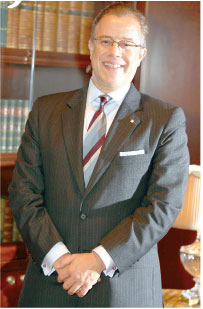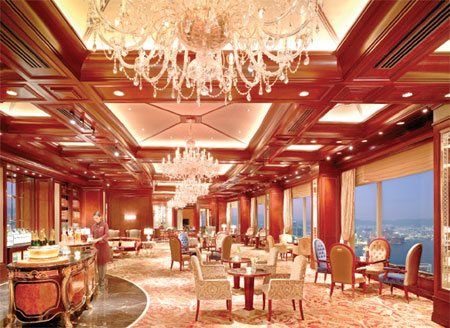Asian flavor a signature feature of the Island Shangri-La
Updated: 2010-10-22 08:29
By Andrea Deng
|
|||||||

As the elevator slowly descends from the 16th floor to the lobby level, one's eyes are automatically drawn through the transparent glass to the large Chinese silk painting of equal height. The painting, called "The Great Mother of China", depicts the country's expansive landscape with a sweeping view of various geographic configurations, ranging from the Yellow Sea in northern China, the Huangguoshu Waterfalls in the southern province of Guizhou, the cliffs of Sichuan and Taishan in Shandong. The size and scale of the painting - the sheer magnitude which Chinese always crave - is only one feature in the work, while the combination of the stillness of mountains and the motion of waters together expresses the fundamental mantra of Confucianism: balance.
And this particular silk painting, which resides in the atrium of Island Shangri-La, also reflects the theme and style of design of the hotel - one of harmony and balance.
When people say that "Island Shangri-La has a strong Asian flavor," what does it mean? The hotel's Interior designer Paul Leese said that it reflects the brand's vision "to bring the character and warmth of the Old World to a new hotel." He deems choice of materials as the key in creating the holistic look, and spent many months of research on just that. The handrails for the staircase, for example, were made from solid timber specially crafted in Thailand. Guestrooms and suites have their sheets with dark-red base color and golden patterns on, curtains and carpets mainly of light brown or medium brown, walls are adorned with Chinese paintings or an ancient folding screen for decoration, and wardrobes simulating those in the imperial palace during the Qing Dynasty, painted stark black with red patterns and golden locks.
Besides that, female concierges are wearing Qipao, the tightly-tailored signature Chinese dress. Around 75 percent of the staff can speak Mandarin. Other service languages include Japanese, Thai, Korean and Tagalog, the language spoken in Philippines. Its Lobby Lounge supplies with a large range of Chinese tea, including non fermented green teas from Zhejiang Province, semi fermented Tieguanyin from Fujian Province, and late fermented Pu Erh from Yunnan Province. The hotel's restaurants feature different Asian cuisines including the Michelin one-star Summer Palace serving Cantonese food.
However, if the Asian touches bring a more visceral perspective on the traditions of the Shangri-La brand promise, it must also be remembered that the Shangri-La hotels' endeavor is far more than that. Hong Kong's hotel business has long been part of a hospitality industry that largely contributes to the region's economy through both good times and bad. Almost every hotel in the city is geared and updated to a certain degree to ensure a steady influx of guests. Although Hong Kong has the upper hand to be right next door to the mainland, where the market is growing rapidly, the newly rich from across the border have intentionally or unintentionally cultivated a more critical sense towards hotel services. It would be nave to simply hinge on a trend elsewhere without refining its own services.
Island Shangri-La is very clear about this. In December 2009, the hotel just launched the Horizon Club on its 52nd to 56th floors, which includes an executive lounge, Peak view and Harbour view rooms, and a Roof Garden. Guests are personally escorted once they arrive at the hotel, and conduct an independent check-in and check-out service. They are also able to use secretarial services and facilities without going to the business center, enjoying a complimentary breakfast from the Michelin two-star French restaurant Petrus, and evening cocktails or champagne in the lounge.
The lounge, on which the hotel spent $3.8 million, stresses "recognition" of the guests as the most important feature. "What separates a great hotel from a not-so-great hotel is getting smaller and smaller. So recognition and personalization are really the focus areas," said Vice President and General Manager Darren Gearing.
The personalized service basically means finding out as much about the guests' penchants as possible. Staff observe what their guests like or don't like through chats with their guests sifting out hints. If the guests prefer lobster to beef, for example, the staff will have the power to work with the chef to have that food available. The next step is to make sure what has been anticipated is readied on the guests' next visit. According to Ilona Yim, Director of Communications of the hotel, many regular guests have become friends with the staff in the Horizon Club, and demand the same concierge on their next visit.
The concept of "club lounge" is not necessarily a new one, according to Mr Gearing, but up until December last year, Island Shangri-La was one of two Shangri-La hotels that did not have a Horizon Club Lounge. Many of the hotels' regular guests who stayed in other Shangri-La hotels were asking the Island branch. So there was a demand from its guests.
China Daily


(HK Edition 10/22/2010 page12)